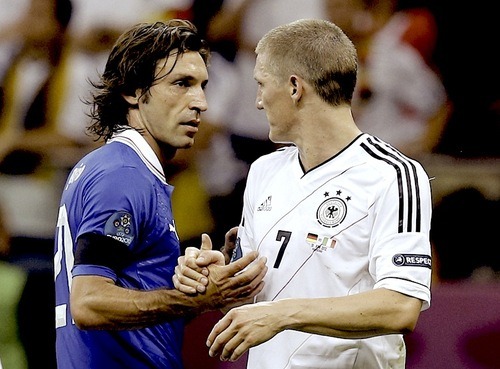It’s been coming! Erik ten Hag’s has been sacked, first boss this season to get the boot and Manchester United are at a crossroads. Ineos, sorry, but you’re already starting to look like Glazer lite with a decision that could (and should) have been made after the FA Cup Final. The club is now assessing the potential replacements, and in typical United fashion there seems to be disjointed thinking with each of the proposed replacements offering a very different tactical setup and – crucially for us in the Statr League and or EPL players – influence on player points. So we wouldn’t be good football nerds if we didn’t dive in. As our self-professed tactician I have taken it upon myself to look at the five most likely replacements: Ruben Amorim, Graham Potter, Ruud van Nistelrooy, Gareth Southgate, and Thomas Frank, and what their appointments could mean for United’s squad and fantasy football prospects. What’s the style of play, the philosophy as you might say, and who are the likely winners and losers in each boss’s set up which could dramatically shape United’s on-field dynamics For fantasy football coaches, this choice could have significant implications for player point trends.
1. Ruben Amorim: The 3-4-3 Innovator

Ruben Amorim is currently with Sporting CP and looks the most likely to be the next one in the dugout over at Old Trafford. As the club already has a lot of Latin influence from Bruno to Dalot and a few in between, is he the second coming of Jose? At 39 years of age, Amorim is one of the most highly sought after coaches in football right now, and with his Sporting Director from Sporting taking over from Tixi at City he has been touted as the long term replacement for Pep Guardiola. Amorim has gained a reputation for his adaptive and fluid 3-4-3 come 3-5-2 formation. Amorim’s tactical approach emphasizes high pressing, quick transitions, and a strong reliance on wingbacks to provide width. There is a train of thought doing the rounds currently that the new structure at United with Wilcox, Berrada and Ashworth have been working on this a while. The club currently have 6 centre backs on their books and purchasing a Wilcox signing in Ugarte (who happened to play under Amorim over the Ten Haag choice of Amrabat) there is a slight stench of “this has been in the pipeline”. Under Amorim, United could see a more structured yet aggressive approach, relying heavily on players who thrive in wide areas and quick interchanges.
Key Tactics:
- Formation: Primarily 3-4-3 with an emphasis on wingbacks pushing high.
- Defensive Setup: High press and aggressive, aiming to win back possession quickly.
- Offensive Play: Wing-focused play with an emphasis on fluidity and quick transitions.
Fantasy Impact:
- Winner: Diogo Dalot/ Luke Shaw/ Noussair Mazraoui– Under Amorim’s setup, wingbacks play a vital role in attack, Mazzy, Dalot or Shaw could see increased attacking returns from crosses and assists.
- Loser: Marcus Rashford – If Amorim sticks to a strict 3-4-3, Rashford may find himself positioned more tucked in centrally or further back, reducing his scoring opportunities and goal threat. A typical Amorim setup means Rashford needs to move centrally which as we have seen time and time again isn’t his strong suit whereas getting chalk on the boots out wide to come inside is more his style,
2. Graham Potter: Flexibility and Possession Play

Known for his flexible approach – and last seen at the shitshow that was and is Chelsea F.C – Potter has been in the wind of late but as we all know, once you show up on Monday Night Football you’re ready to come back to the game…and guess who was the a recent guest on MNF? Why, that would be Mr Graham “I’m not a wizard Harry” Potter. During his time at Ostersund, Swansea and most notably Brighton before the ill fated Chelsea stint, Graham Potter has shown a preference for possession-based football and tactical adaptability. His setups at Brighton were often varied, making it hard to pin down an exact formation, but he typically favoured either a 3-4-2-1 or a 4-2-3-1, designed to keep the ball and create chances through sustained buildup. He is high up the list of potentials as he is a young, fashionable and relatively experienced manager and as we have seen over the recent years not having a successful run at Chelsea really isn’t the be-all as managers (Tuchel, Jose, Poch, Conte just to name a few) have recently drank from the poisoned chalice that’s made its home in the West End of London. Potter’s focus on ball retention and positioning could suit United’s technically skilled midfielders and forwards who excel in tight spaces.
Key Tactics:
- Formation: Primarily 3-4-2-1 or 4-2-3-1 with possession-based buildup.
- Defensive Setup: Emphasis on positioning over aggressive pressing.
- Offensive Play: Structured possession play focused on creating quality chances.
Fantasy Impact:
- Winner: Bruno Fernandes – With more control in possession, Fernandes could thrive as the creative hub, increasing his chances of assists and key passes.
- Loser: Antony, Amad – Potter’s preference for narrow formations may limit wide players’ influence, potentially impacting the likes of Amad or Antony’s role and limiting their scoring chances.
3. Ruud van Nistelrooy: Attack-Minded but Balanced

A former United striker, Jesus h Christ we’ve been down this road before haven’t we? Ole 2.0 RVN also has a similarly slim managerial back catalogue as Ole did when he vibed his way into the hot seat. Van Nistelrooy’s managerial style at PSV leaned towards attacking football, often in a 4-3-3 or 4-2-3-1 formation. Essentially, the setup would look and feel alot like Ten Haag’s Manchester United structure with Ugarte, Mainoo and Bruno supporting Amad, Garnacho and Hojlund, and the back 4 being much the same. The only difference might be the pattern of play and attacking structure. He encourages forward-thinking play and relies on direct transitions, but his setups maintain a degree of defensive stability. His approach could reinvigorate United’s attack while bringing a focus on clinical finishing—something van Nistelrooy himself was famous for.
Key Tactics:
- Formation: 4-3-3 or 4-2-3-1 with an attacking focus.
- Defensive Setup: Balanced, with an emphasis on maintaining shape.
- Offensive Play: Fast transitions, aiming to capitalize on quick attacking opportunities.
Fantasy Impact:
- Winner: Marcus Rashford – With a more direct approach, Rashford could be deployed on the inside left channel where he excelled at times under Ole and Ten Haag as the teams primary scorer, potentially boosting his goal tally.
- Loser: Casemiro – With a higher focus on attack, this type of defensive midfielders might see fewer points in terms of interceptions or recoveries as play bypasses them faster. Would expect him to be replaced by an Ugarte or Collyer in and RVN setup.
4. Gareth Southgate: Structured and Pragmatic

Quite possibly (and completely logically) the least popular choice on this list and rightly so is Southgate, who is in the conversation not because of what he did with England but more due to his relationship with Wilcox and Ashworth from their time together in the FA. Gareth Southgate, the ex England coach, has shown a preference for a structured and disciplined approach, frequently using a 3-4-3 or 4-3-3. Harry Maguire to get the captain band and focus on a counter breaking structure with a low block and fast transitions which became the hallmark of his England team. In fairness, despite his total lack of popularity, Southgate might be the most successful English manager ever. His tactics are conservative, prioritizing defensive solidity and minimizing risks. Southgate’s pragmatic style may bring stability to United’s defence but could restrict their attacking freedom, affecting the output of creative players. Which – given how lightweight the attacking output has been over the last 18 months – a compress and spring system might actually be what Manchester United need….even if it would go down like a lead balloon in the Stretford End. Gareth Southgate’s approach prioritizes defensive stability and minimizes risk. He often uses a 3-4-3 or 4-3-3, focusing on structure, balance, and careful build-up rather than aggressive attacking play. His conservative style could stabilize United’s defence, but might restrict the creativity and offensive freedom of players who thrive in dynamic, high-tempo settings.
Key Tactics:
- Formation: Primarily 3-4-3 or 4-3-3, with an emphasis on discipline and positioning.
- Defensive Setup: Structured defensive shape with limited high pressing.
- Offensive Play: Controlled buildup, aiming to create fewer but high-quality chances.
Fantasy Impact:
- Winner: Lisandro Martinez & Harry Maguire– With Southgate’s focus on defensive structure, Martinez and Maguire could benefit from clean-sheet opportunities and increased defensive metrics like clearances and interceptions.
- Loser: Bruno Fernandes – Southgate’s restrictive style might curb Fernandes’ creative freedom, potentially impacting his chance creation and overall fantasy output.
5. Thomas Frank: Tactical Flexibility and High Pressing

While this little writer would personally be looking at Marco Silva, his name doesn’t seem to be on the hit-list which is fine by me but he would have been a tactical and personality fit. Anyway, in the same mould the popular prem choice seems to be Thomas Frank, the manager behind Brentford’s Premier League success. I get it to be honest, he’s knowledgeable, he talks well and is known for his high-pressing, adaptive approach. Often employing a 3-5-2 or 4-3-3, Frank focuses on aggressive pressing, quick transitions, and maximizing set-piece opportunities. Under Frank, United could adopt a high-energy, flexible system that suits players with work rate and tactical intelligence. Which would be fun to watch but without out-and-out forwards that he has had at Brentford in Toney and Mbuemo how would his style suit forwards like Hojlund or Zirkzee? Guess there is one way to find out.
Key Tactics:
- Formation: 3-5-2 or 4-3-3 with a high press and counter-attacking potential.
- Defensive Setup: Pressing from the front to win possession high up the pitch.
- Offensive Play: Quick transitions, utilizing speed and positioning for swift attacks.
Fantasy Impact:
- Winner: Mason Mount – Known for his work rate and pressing ability, Mount could thrive under Frank’s high-energy system, potentially racking up points from successful tackles and interceptions alongside goals and assists.
- Loser: Harry Maguire & De Ligt – With a more aggressive team press, these more “traditional” and slower style defenders may be left exposed, reducing clean-sheet chances and possibly lowering potential fantasy score through defensive gaps.
Final Thoughts: Who Stands to Gain or Lose?
Each potential manager brings a distinct tactical style, but as Manchester United have floundered in the post Ferguson era it’s a bit mental to see a group of managers being highlighted where there doesn’t seem to be a consistent stream of consciousness throughout the selection process. Under Ruben Amorim or Thomas Frank, expect United’s wingbacks and hard-working midfielders to see an uptick in fantasy points. Meanwhile, under Gareth Southgate, defenders might shine with clean-sheet potential, while attackers may see fewer scoring opportunities. It’s really a case of see who takes the hot seat and then we can fully understand potential shifts in player performance for fantasy football managers to consider.
Choosing the right manager is not just about results on the field—it’s also about maximizing player potential and aligning with a strategy that brings out the best in every position. For fantasy managers, keeping an eye on United’s managerial decision could unlock new value or risks for players across the squad, from defensive assets to those tasked with creating and finishing chances. For now all we know is Eric Ten Haag’s reign is over, and the Ineos Trinity of Ashworth, Berrada and Wilcox have a job on their hands.



Comments are closed